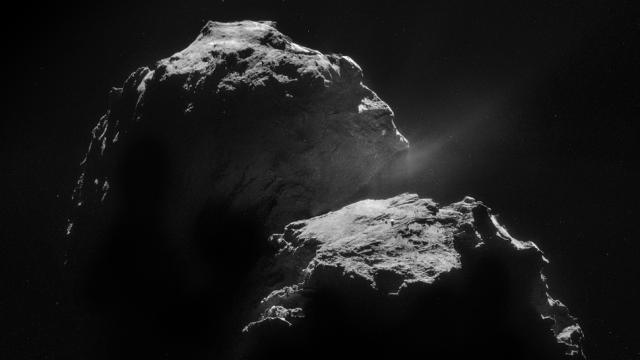The historic Rosetta mission has finally come to an end. Over the past two years, the probe’s many instruments have scanned virtually every nook and cranny of this weirdly shaped rock, unleashing a treasure trove of new information about comets in general, and 67P/Churyumov — Gerasimenko in particular.
A glorious shot of of Comet 67P/Churyumov-Gerasimenko. (Image: ESA/Rosetta/NAVCAM, CC BY-SA 3.0 IGO)
When Halley’s Comet paid us a visit back in 1986, the European Space Agency’s Giotto spacecraft was sent to explore the incoming ball of ice and dirt. By the time the mission was over, it became glaringly obvious that if we were ever going to learn anything about comets, we’re going to have to get a bit closer. Like, a lot closer.

Conceptual image of Rosetta and Philae. (Image: ESA)
So the ESA began to brainstorm a number of concepts, but the one that eventually came to fruition was the Rosetta Mission. Among the project’s many lofty goals, the mission planners sought to put a space probe in orbit around Comet 67P/Churyumov — Gerasimenko, or simply 67P, and then to have it fly alongside the celestial object as it made its way around the Sun.
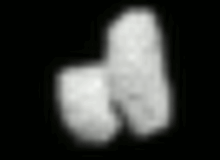
In addition to being equipped with a diverse set of measuring instruments and cameras, Rosetta was also supplied with the Philae Lander — a probe within a probe that was to land on the comet itself.
Launched on 2 March 2004, the Rosetta probe began to make its way towards the comet, passing by Mars and several large asteroids along the way. Several weeks after its launch, Rosetta used its dual imaging camera to take its first picture of the comet.
As the probe got closer, mission scientists were shocked to discover that the comet was… well… really weird. Known as a two-fold comet, it bore a startling resemblance to a rubber ducky. Follow-up studies showed that the comet merged from two separate objects.
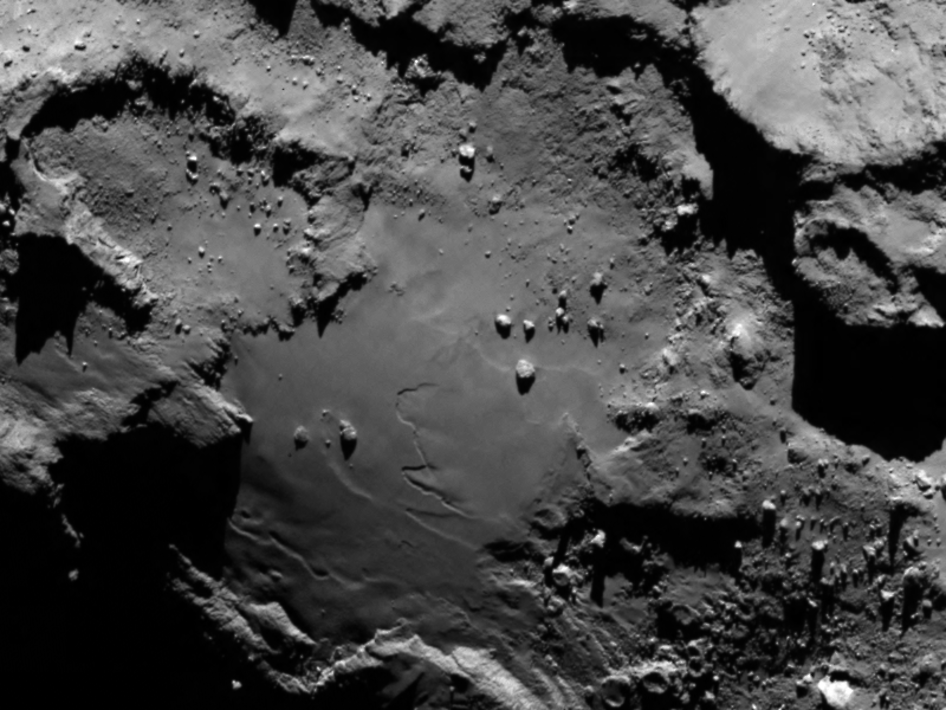
The first close-up images revealed boulders, dunes, sinkholes and cliffs. (Image: ESA/Rosetta/MPS for OSIRIS Team)
Rosetta arrived at Comet 67P on 6 August 2014, and a flood of amazing pics soon followed. Taken from a distance of just 130km, the first close-up images ever taken of a comet revealed boulders, craters and steep cliffs — including an epic 1km cliff that would rival anything found on Earth.
On 12 November 2014, the Philae Lander began its slow descent towards the comet, but things didn’t go exactly as planned. Instead of securing itself to the surface with its harpoon-fired grappling hooks, Philae bounced several times, and eventually settled within a shadowed crevice.

Now that’s a cliff. (Image: ESA/Rosetta/NAVCAM — CC BY-SA IGO 3.0/Stuart Atkinson)
Unable to draw solar energy from the Sun, Philae went into hibernation mode. It awoke briefly a few months later, but was eventually declared dead. The lander was finally discovered on 5 September 2016.
It wasn’t exactly what the mission planners had hoped for, but the experience still managed to produce some meaningful data.
As Philae made its harrowing journey across the surface of the comet, its onboard sensors were busy collecting important data. Based on the lander’s initial contact with the comet, the researchers learned that the surface, at least at the landing site, was comprised of a soft, mushy layer about 30cm thick.

Inset images show Philae as it drifted across the comet surface. (ESA/Rosetta/MPS for OSIRIS Team MPS/UPD/LAM/IAA/SSO/INTA/UPM/DASP/IDA)
Below this granular layer of regolith was a surprisingly solid layer of rock. The hardness of this layer may explain why only one of Philae’s legs was able to anchor itself to this lower surface level. Data from Philae suggests that the upper layers of the comet’s surface consist of dust that’s about 10 to 20cm thick.
And Rosetta isn’t solid all the way through. It is filled with a surprising amount of dust. Studies of the comet’s gravitational pull suggests that its interior is not filled with caverns and tunnels, but is relatively consistent throughout.
As the data streamed in from Rosetta and Philae, scientists sought to make sense of it all. In late January 2015, a batch of preliminary findings were published in the journal Science. Among the many surprising discoveries, scientists observed ripples and dunes on the comet’s surface, which was completely unexpected given that the comet lacks an atmosphere (and therefore wind) and experiences very little gravity.
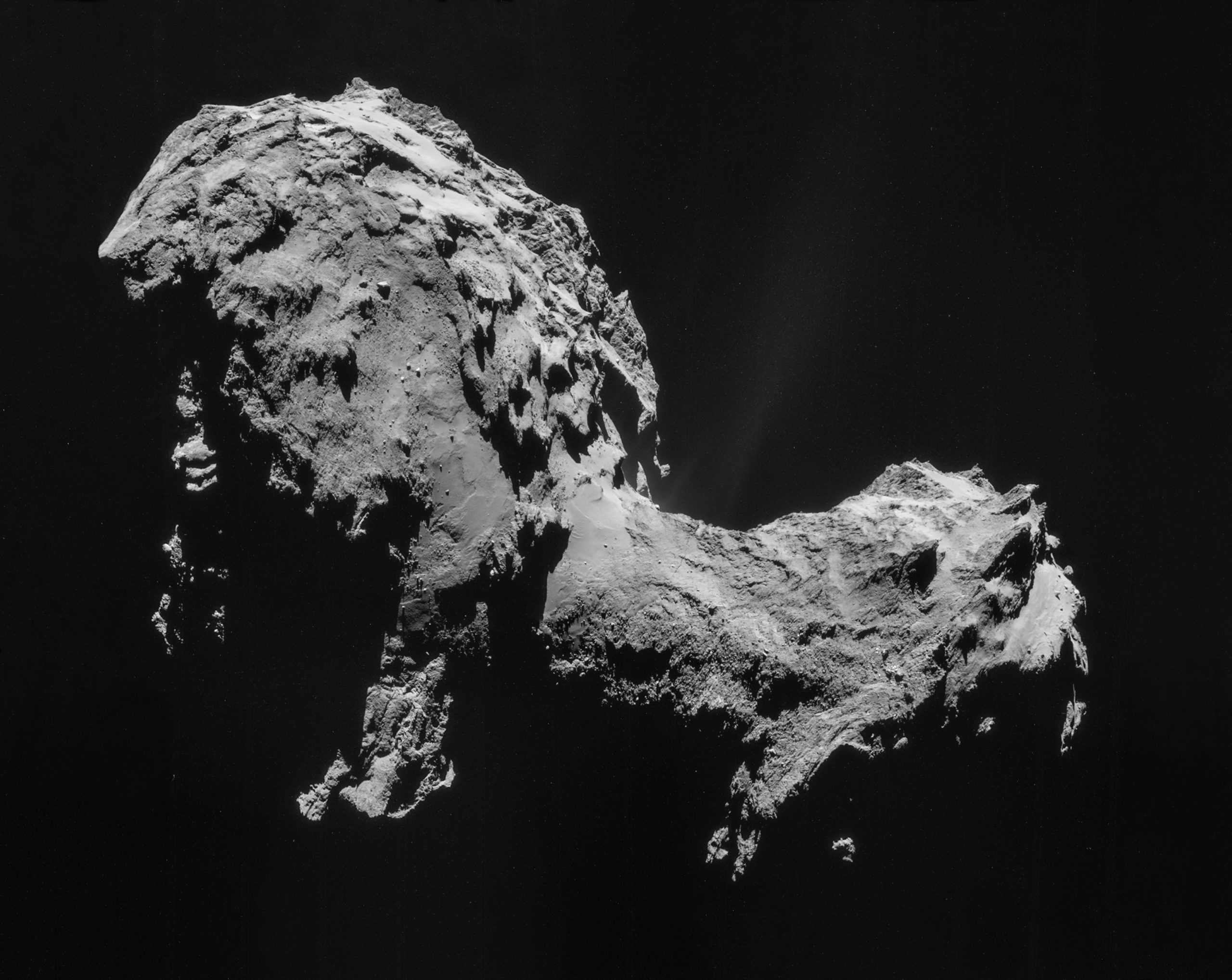
A strangely shaped ball of water ice, rock and a lot of dust. (Image credit: ESA/Rosetta/NAVCAM, CC BY-SA IGO 3.0)
To explain the phenomenon, scientists speculated that jets of gas and dust were substituting for wind, and the particles were bound together by the van der Waals force (weak, short-ranged electrostatic forces between uncharged molecules) instead of gravity.
Mission scientists also began to paint a picture of the comet’s chemical composition. Using the Rosetta Orbiter Sensor for Ion and Neutral Analysis (ROSINA), the scientists detected water, carbon monoxide, carbon dioxide, ammonia, methane and methanol. But the chemical cocktail didn’t stop there; ROSINA also sniffed out formaldehyde, hydrogen sulfide, hydrogen cyanide, sulphur dioxide and carbon disulfide.
Taken together, it became clear that this comet really stinks. Here’s how a mission scientist described its foul stench:
The perfume of 67P/C-G is quite strong, with the odour of rotten eggs (hydrogen sulphide), horse stable (ammonia), and the pungent, suffocating odour of formaldehyde. This is mixed with the faint, bitter, almond-like aroma of hydrogen cyanide. Add some whiff of alcohol (methanol) to this mixture, paired with the vinegar-like aroma of sulphur dioxide and a hint of the sweet aromatic scent of carbon disulphide, and you arrive at the ‘perfume’ of our comet.
Not only does the comet have a smell, it apparently also has a characteristic noise. Here’s what the “singing” comet sounds like.
And then there were the mysterious balancing boulders.
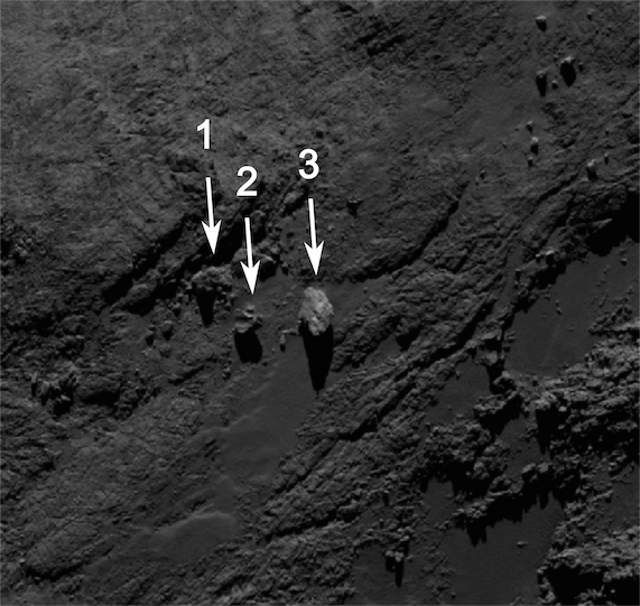
Rosetta’s balancing boulders. (SA/Rosetta/MPS for OSIRIS Team MPS/UPD/LAM/IAA/SSO/INTA/UPM/DASP/IDA.)
Using the OSIRIS camera aboard Rosetta, scientists caught a glimpse of a strange formation of what appeared to be three boulders balanced in an extremely precarious position on the comet surface. Similar objects appear on Earth, the result of erosion or glacial measures, but how “this apparent balancing rock on Comet 67P/C-G was formed is not clear at this point,” noted OSIRIS Principal Investigator Holger Sierks soon after the discovery.
One theory is that cometary activity caused the boulders to move from one location to another, a process that would indicate evolving exo-geological processes on the comet. Another possibility is that the rocks weren’t actually balancing, and that the shadows were playing tricks with the researchers.
Thanks to Philae, we also learned that organic molecules exist on the comet — though not necessarily the kind that can deliver the chemical prerequisites for life. Organic molecules, that is, molecules with one or more carbon atoms within them, are abundant in the cosmos, so this discovery wasn’t all that revealing. That said, a study put out earlier this month shows that complex organic molecules — the kind that form the basis of our biology — exist in the dust around the comet. This bolsters the argument that the basic building blocks of life may have been delivered to Earth via icy space rocks.
Comets like 67P may have peppered Earth with the building blocks of life, but they likely didn’t bring water to our planet, according to scientists who analysed the quantity and quality of water vapour streaming from the comet. Simply put, the kind of water found on the comet doesn’t match the kind of water found on Earth. The water on the comet features a different chemical composition. This suggests that asteroids, and not comets, were the primary delivery mechanism of water to our planet.
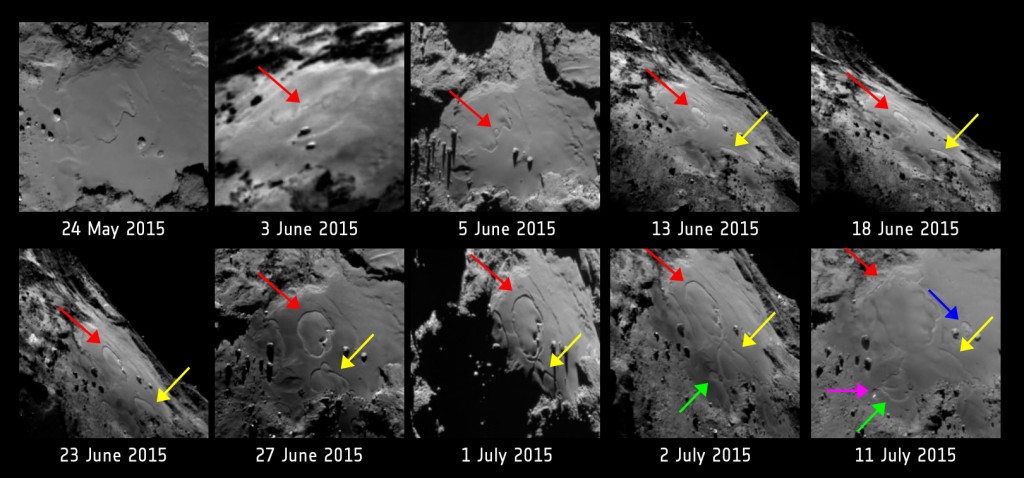
Photos taken of the same site from May 24 to 11 July 2015. (Image: ESA)
In the months that followed Rosetta’s arrival, the surface largely remained static, but things had changed by the midpoint of 2015. A number of land features disappeared, while others suddenly popped up from nowhere. The scientists weren’t sure about the cause, but they said it might have been the result of weak surface materials, which allowed for rapid erosion.
As the comet approached its perihelion (its closest approach to the Sun before heading back towards the outer solar system), it started to come alive.
Images taken in August 2015 showed jets sprouting from the comet’s surface, spewing 60 to 260 tonnes of cometary dust with a single shot. For the first time ever, scientists had an opportunity to witness ice as it sublimated and exploded in the form of these dramatic dust-loaded jets. Meanwhile, chunks of ice ranging from a one to 40m in diameter were thrown into space. As the intense radiation from the sun bombarded the comet, fractures splintered across its tortured surface.
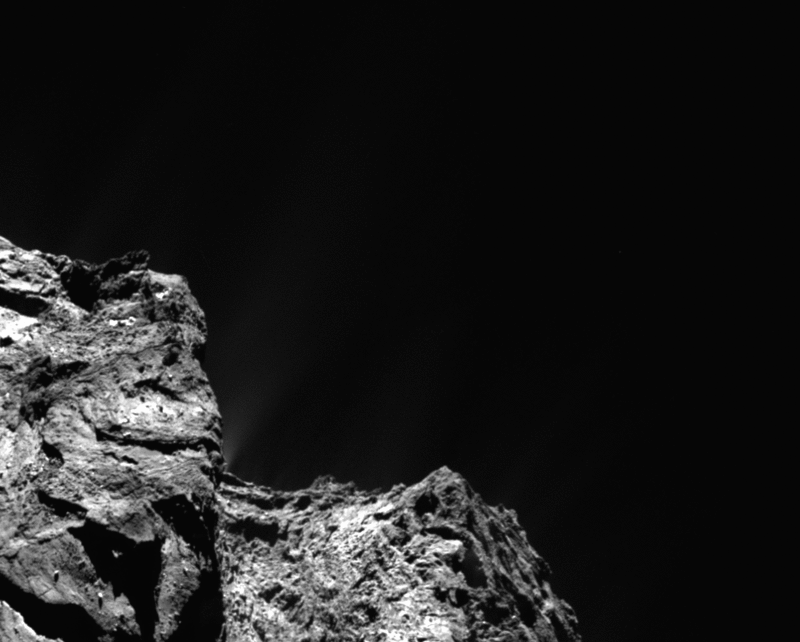
Powerful jets began to sprout from the surface during the winter of 2015. (ESA/Rosetta/MPS for OSIRIS Team MPS/UPD/LAM/IAA/SSO/INTA/UPM/DASP/IDA)
Follow up studies showed that these weird eruptions happened on the edge between one geographic feature and another, and at dawn when the Sun re-appeared (the comet is clearly not a morning person).
Another surprising discovery was the presence of actual weather on the comet — an unexpected phenomenon given that this rock has no atmosphere to speak of. It’s driven by the comet’s intense day-night cycle. Ice patches on the surface transform into a cloud of water vapour when the Sun rises, growing again when its “neck” (the thin mid-section of the comet connecting the two lobes) rotates into darkness. This vapour is lost to space, but the discovery suggests that the comet’s surface ice, some of which is just beneath the surface, is replenished from below, probably through fissures that expand during the day.
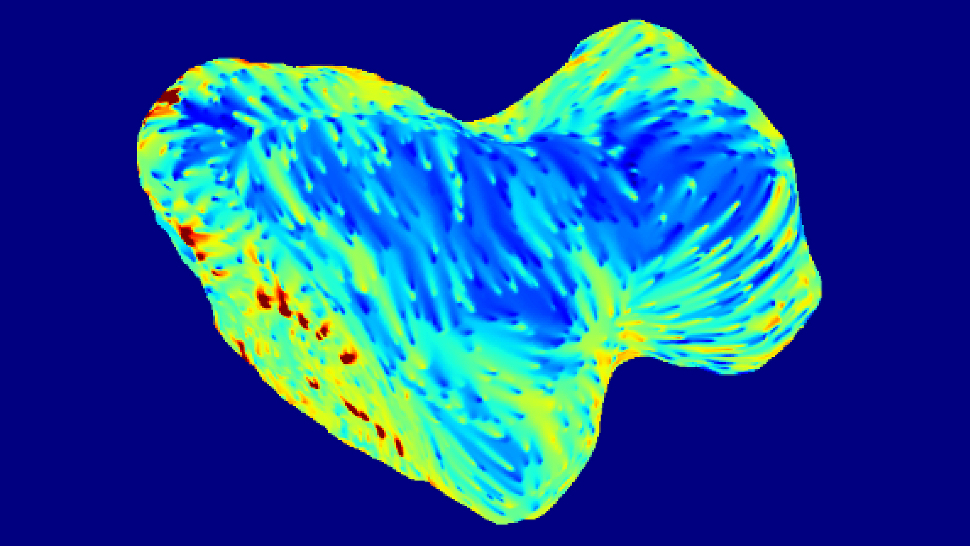
A side we don’t often see — the comet’s “dark side”, which faces away from the Sun. A special camera aboard Rosetta allowed scientists to create a visual extrapolation of the comet’s obscured underbelly. (Image: ESA/Rosetta/NASA/JPL-Caltech)
Another shock came in October 2015, when scientists detected traces of molecular oxygen, something that had never been seen before in a comet’s coma (the cloud of dust and gas surrounding a comet). This free-floating oxygen shouldn’t have been there, prompting the scientist to speculate that the comet has an interior source of molecular oxygen to replenish the diminishing molecules on the outside. In fact, the comet may be bleeding oxygen that’s older than the sun.
Even as Rosetta made its final death plunge onto the surface of the comet, mission scientists were busy collecting data. Its final resting place — named Ma’at after the ancient Egyptian goddess of harmony, balance and order — is a region strewn with boulders and treacherous sinkholes. By exploring this area in detail, scientists hope to gain a better understanding of how comets form.
Rosetta may be dead, and the exploratory part of the mission may be over, but there’s still plenty of work to be done, and many mysteries yet to be solved.
